Atomic spectrometry update. Review of advances in the analysis of metals, chemicals and materials
Abstract
This review period has seen some changes to the format of the review. These changes are intended to more accurately reflect the current state of analytical research in the analysis of metals, chemicals and materials. As a consequence, the title of the review and some of the section headings have been altered to reflect this. Significant areas of growth include the use of LIBS in remote analysis, especially of explosives and nuclear materials. The stand-off capability of the technique makes it very desirable in these areas. The use of chemometrics and procedures for removing substrate interferences are proving to be effective in making the technique more quantitative. It is also beginning to be reported for use in Process Analysis in the pharmaceuticals industry and has been employed to investigate the processes occurring within an engine and to model the processes occurring in explosions. The analysis of archaeological, cultural heritage and art objects continues to be a significant area of research, with some interesting developments in multi-analytical techniques which are employed to yield maximum information with as little disruption to the object as possible. Similarly, the high resolution capabilities of synchrotron radiation are being increasingly employed for high value objects where the cost of the analysis is outweighed by the benefits. In the field of materials analysis, the development of techniques for investigating the growth of novel material structures is a significant activity, e.g., the nucleation of alpha Alumina via titania templates, studied using a range of techniques. Papers outlining advances in the use of asymmetric field flow fractionation with a multi-detection approach for the characterisation of particle size and size distribution are reviewed as is a comparison of hydrodynamic chromatography with AFFF. Papers dealing with single particle analysis are also reviewed. The catalyst section is shorter than in previous reviews and this reflects the fact that fewer new developments in analytical chemistry are being published. The emphasis is on advances in the analysis of catalyst materials. This is the latest review covering advances in atomic spectrometric measurements of metals, chemicals and materials. It follows on from last year's review1 and should be read in conjunction with other reviews in the series.2–5 This year will be the last time that Mike Hinds will write for the review. His contribution over many years has been very significant and greatly appreciated. We welcome John Marshall to the writing team.

- This article is part of the themed collection: Atomic Spectrometry Updates

 Please wait while we load your content...
Please wait while we load your content...